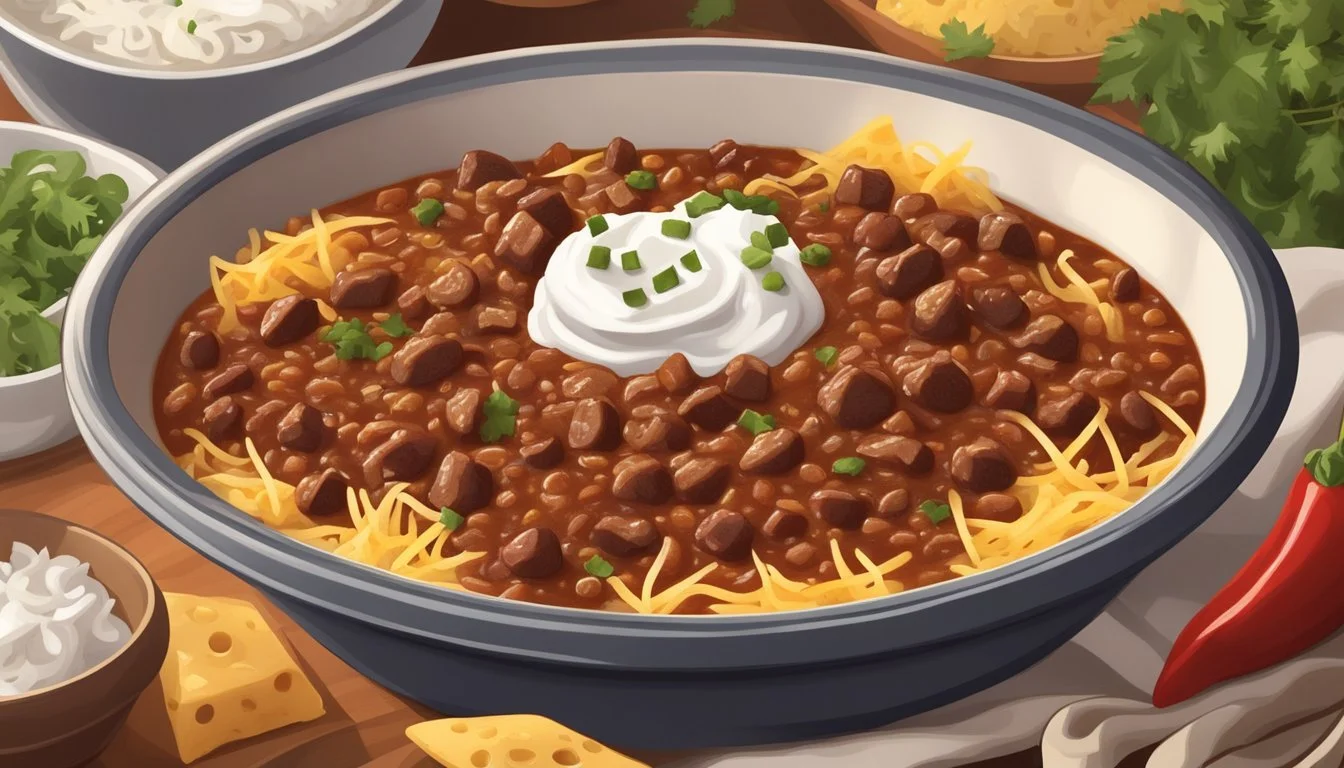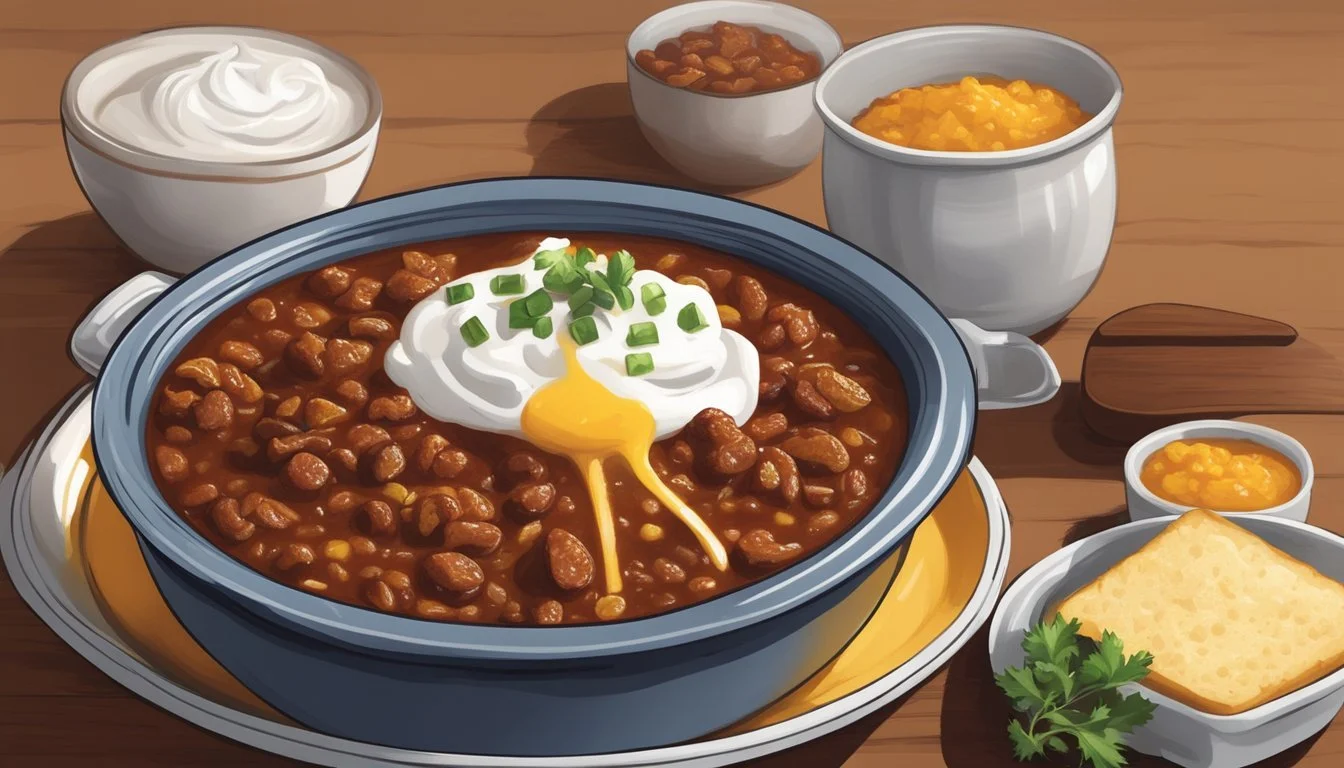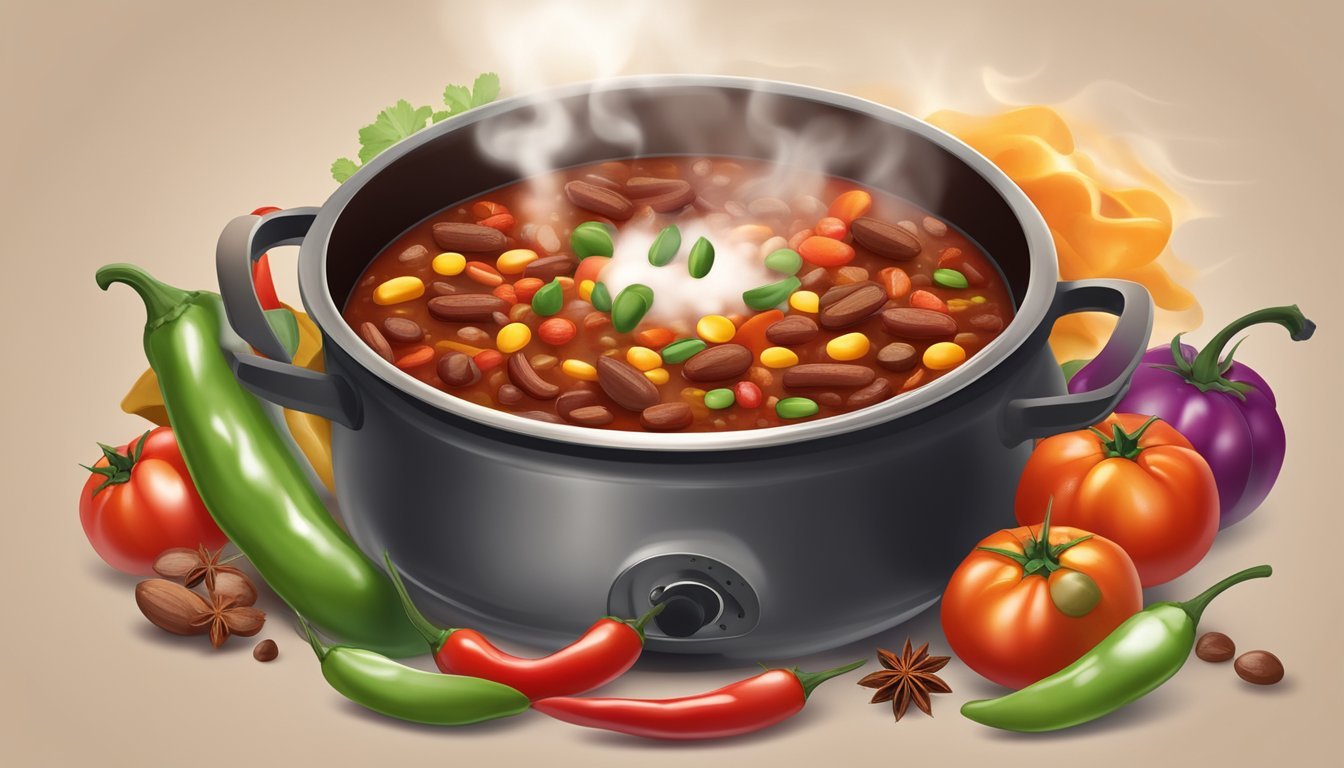Texas Style Chili Con Carne
A Classic Recipe Decoded
Texas-style chili con carne is a hallmark of Texan cuisine, symbolizing the state's rich culinary traditions with its bold flavors and hearty ingredients. This regional dish eschews the beans and tomatoes often found in other variations, focusing instead on the fragrant and robust combination of tender beef (how long does beef last?) and a complex blend of spices and chilies. Dating back to the original cowboy fare of the 19th century, chile con carne has evolved, but Texas-style chili remains true to the spirit of its origins, with simplicity and spice at its core.
The term 'chile con carne' translates to 'chili with meat', which accurately describes Texas chili's essence, a stew-like mix where the meat is the star, simmered to perfection with chili peppers and various spices. In a traditional recipe, chunks of beef are seasoned and browned to develop a depth of flavor. After browning the meat, it is slowly cooked with chilies that have been carefully selected to deliver heat and a depth of complex and satisfying flavor. The result is a warm, hearty dish that has become synonymous with Texan identity and pride.
Making Texas-style chile con carne involves a balance of flavors achieved through a blend of spices that often include cumin, garlic, and onions alongside chili powders or whole chilies. Cornmeal (how long does cornmeal last?) sometimes thickens, subtly contributing to the chili's texture without overshadowing the main ingredients. As the chili slowly cooks, the flavors meld together, creating a dish that is not just a meal but a time-honored tradition that serves as a warm welcome to friends and family, akin to Texas hospitality.
History and Origin
Chili con carne, often known simply as chili, is a dish with deep roots tied to Texas, where its evolution is a blend of Mexican tradition and Texan innovation. The precise origin of chili con carne is a blend of cultures, but it indisputably became a part of the Texan identity.
Traditional Ingredients
Chili is traditionally a spicy stew containing chili peppers and meat, typically beef. This dish is recognized for its lack of beans in Texas-style recipes—a point of contention among chili enthusiasts. The Texan version prides itself on a simple yet potent combination of ingredients that focus on the following:
Stew Meat: Usually, a hearty cut of beef, like a chuck, stands up to long cooking times, and cooked bacon (how long does bacon last?).
Chili peppers: Provides the characteristic heat and flavor and can include varieties like ancho, poblano, or jalapeño.
Onions and Garlic: Sautéed as a base for their aromatic qualities.
Tomatoes: Added for acidity and balance, though some purists argue about its inclusion.
Spices: Often a blend of homemade chili powder, cumin, oregano, and often other spices like paprika or cayenne pepper.
It is crucial to note that beans, a common ingredient in various chili recipes, are traditionally absent in the Texas rendition—reflecting the dish's roots in Mexican cuisine, prioritizing meat and chili peppers.
Originating in the 1800s, chili became a part of American culinary history through the "Chili Queens" in San Antonio, Texas, popularizing the dish. The women of San Antonio, known as the Chili Queens sold chili that was made with dried chilis and beef in the Military Plaza Mercado. The Chili Queens still stand as unique institutions of the Alamo.
It reflects an amalgamation of cultures, standing as a symbol of Tex-Mex cuisine, one that has not only endured but also sparked a bevy of recipes, contests, and a state-wide passion for this robust stew.
Essential Ingredients
The right ingredients are vital for creating an authentic Texas-style chili. They impact the flavor, texture, and overall authenticity of the dish. The selection of meat, types of chili used, the role of tomatoes and onions, and flavor-building spices and herbs define Texas chili.
Meat Selection
For a traditional chili, beef is the cornerstone, with beef chuck or chuck roast being the most popular choice. This cut of beef is preferred for its balance of meat and fat, which ensures tender chunks after long hours of simmering. Pork shoulder is a substitute some cooks turn to, which is cheaper and benefits from the long slow cooking over a medium heat.
Chili Peppers and Powders
For some of the best Mexican food the heart of chili con carne lies in its chili component. Combining dried chile peppers such as pasilla, guajillo, or ancho chiles provides rich flavors, while chili powder offers a smoky complexity. Jalapeño, poblano peppers, and red bell pepper can enhance the chili with additional flavor and heat.
Tomatoes and Onions
Diced onions are a foundation for the base, contributing sweetness and depth, whereas crushed tomatoes can be a point of contention. Some purists omit them, but they lend acidity and richness to the dish when included. Typically, the recipe calls for fresh or canned tomatoes(how long does canned tomatoes last?).
Flavor Builders
The flavor profile of chili is built on a foundation of spices. Cumin, oregano (preferably Mexican oregano), and garlic are quintessential. While some recipes may include beans or a variety of other ingredients, classic Texas-style chili con carne focuses on the meat and chili flavors and often excludes beans from the list of essential ingredients. To build the dish's flavor, chicken broth (how long does chicken broth last?) can be added after browning the meat.
Cooking Techniques
Essential to the success of Texas-style chili con carne is the mastery of specific cooking techniques applied during the preparation process.
Browning the Meat
Meat browning is the crucial first step. The cook sears the chuck roast or similar cuts of beef in small batches in a dutch oven to ensure each piece is well-browned on at least one side. This imparts a rich, caramelized flavor and develops a complex base for the chili. It's recommended to use a heavy-bottomed large pot or a Dutch oven and to retain some bacon fat, if available, to prevent sticking while encouraging full flavor development and stirring occasionally.
Simmering the Chili
Once the meat is seared, the next phase is simmering. The beef is combined with a blend of spices and chiles to make the chili sauce. Add salt and then it is then allowed to simmer over a medium heat for a few hours, typically in the same pot used for searing. This method will enable flavors of the chili sauce to meld and the meat to become fork-tender. The heat should be kept low and steady; rushing this process can produce less flavorful chili. Covering the pot partially can prevent excess evaporation while simmering in the oven or stovetop.
Flavor Enhancement
The essence of a remarkable Texas-style chili con carne lies in the meticulous selection and use of spices, seasonings, and additional flavorings. These elements are pivotal in achieving the deep, complex taste that characterizes this iconic dish.
Spices and Seasonings
Chili con carne's depth of flavor begins with spices. Ground cumin and coriander are fundamental, imparting earthy tones and a hint of citrus. Kosher salt (how long does kosher salt last?) and black pepper are essential for enhancing these flavors.
Chili Flavor: Integral to Texas chili, various dried chilies such as ancho or chipotle add a robust chili flavor without overwhelming heat.
Mexican Oregano: Unlike its Mediterranean counterpart, Mexican Oregano lends a slightly more intense flavor appropriate for chili con carne.
Using a combination of these spices contributes to an authentic Texas chili:
Spice Purpose Ground Cumin Adds warmth and earthiness. Coriander Lends a touch of citrus and spice. Kosher Salt Enhances all other flavors. Black Pepper Provides a subtle heat. Mexican Oregano Offers a bolder flavor than traditional oregano.
Additional Flavorings
Beyond spices, additional elements enrich the chili further:
Beef or Chicken Stock: A quality beef stock is the primary liquid, providing a rich base.
Beer: Incorporating beer as a part of the liquid base can add a malty undertone.
Bacon: A small amount of bacon introduces a smoky dimension and added depth.
Cocoa Powder/Chocolate: A subtle addition of cocoa powder or chocolate complements the chili's spiciness and adds complexity.
Adobo sauce from canned chipotle contributes both heat and a touch of sweetness. The addition of these flavorings should be considered an art where balance is critical:
Flavoring Contribution Beef Stock Adds depth and richness to the base. Beer Contributes complexity and richness. Bacon Provides smokiness and depth of flavor. Cocoa Powder/Chocolate Offers a rich and subtle complexity.
By understanding each spice's role and additional flavoring, one can enhance the flavor profile of Texas chili con carne with confidence and finesse. The precise layering of these ingredients gives this dish its distinctive taste.
Serving and Garnishing
When presenting Texas-style chili con carne, the selection of accompaniments and toppings can enhance the dish's texture and flavor. It's important to consider offering various options to suit individual preferences.
Accompaniments
For a traditional experience, cornbread serves as a hearty and classic side that complements the richness of the chili. Alternatively, warm flour tortillas or those made from masa harina (how long does masa harina last?) provide a delightful vessel for scooping up every savory bite. These starches add a comforting element that balances the boldness of the chili.
Cornbread: A sweet and crumbly texture that contrasts the spicy chili.
Tortillas: Soft flour or corn enhances the meal's authenticity and savor.
Toppings
The right toppings add a visual appeal and introduce various flavors and textures to the dish. A dollop of sour cream can mellow out the heat, while shredded cheese melts beautifully over the hot chili for a creamy addition. Fresh cilantro lends a burst of herbaceous freshness, and lime wedges allow guests to add a spritz of tangy brightness.
Topping Description: Sour Cream Offers a cooling contrast to the chili's spicy elements. Cheddar Cheese Introduces a creamy, rich layer to the dish. Cilantro Provides a fresh, aromatic touch. Lime Wedges: Add a zesty kick when squeezed over the chili.
By offering an array of accompaniments and toppings, each person can customize their bowl to suit their taste, and these additions transform the chili into a personalized dining experience.
Variations and Substitutes
When crafting Texas-style chili con carne, chefs can swap traditional ingredients with alternatives that cater to different dietary needs or preferences without compromising the dish's robust flavor.
Protein Variations
Traditional Beef: Stew meat is the protein of choice for classic Texas chili. Usually, beef chuck is cut into hearty chunks. This can be substituted with ground beef for a different texture or a combination of the two.
Chicken: As a leaner alternative, chicken, specifically dark meat for added flavor, can be used. It’s important to note that chicken will cook differently and generally requires less time than beef.
Vegetarian Alternatives
Beans: While traditional Texas chili is known for being a "bowl of red" without beans, they can serve as a hearty substitute for meat in a vegetarian version.
Vegetarian Grounds: For a similar texture to ground meat, vegetarian grounds are an effective substitute. Numerous brands offer products that mimic the consistency and absorb the spices well to suit this iconic dish.
Storage and Reheating
When storing Texas-style chili con carne, ensuring the dish maintains its flavor and safety for consumption is critical. Proper refrigeration and freezing methods can extend the dish's shelf life, allowing one to enjoy the hearty stew later.
Refrigeration
Texas-style chili con carne should be refrigerated within two hours of cooking to prevent bacterial growth. One can store leftovers in an airtight container to retain flavor and freshness. It is recommended to consume the chili within 3 to 4 days when stored at or below 40°F.
Containers: Airtight, shallow containers
Temperature: At or below 40°F
Shelf Life: 3 to 4 days
Freezing
For more extended storage, freezing Texas-style chili con carne is an effective option. To freeze, allow the chili to cool completely, then transfer it to freezer-safe bags or containers, leaving some space for expansion. Properly stored, the chili can last for up to 4 to 6 months in the freezer. Thawing should be done in the refrigerator overnight.
Preparation for Freezing:
Cool completely
Use freezer-safe bags or containers.
Leave space for expansion.
Thawing Method: Refrigerator overnight
Shelf Life in Freezer: 4 to 6 months
Nutritional Information
Texas-style chili con carne is a hearty stew notable for its robust blend of spices and tender beef. This dish's nutrition can vary depending on the ingredients and portion sizes. Still, the following is a general guide to its nutritional content per serving, typically around one cup.
Calories: A serving of Texas-style chili con carne typically contains around 250 to 300 calories. Caloric content can be higher if the chili contains more meat or additional fat sources like cheese or sour cream added as toppings.
Fat: The total fat content is approximately 10 to 15 grams per serving. This amount can include both saturated and unsaturated fats, varying with the choice of meat and cooking methods.
Saturated Fat: Around 4 to 6 grams
Trans Fat: Minimal to none
Polyunsaturated Fat: May include 0.5 to 1 gram
Monounsaturated Fat: Typically present in several grams
Protein: This dish is high in protein due to its beef content, offering about 20 to 25 grams per serving. The exact amount depends on the cut of beef and how much is used.
Carbohydrates: Chili con carne contains carbohydrates primarily from vegetables like tomatoes and any thickening agents such as cornmeal if used. A serving generally provides 20 to 30 grams of carbohydrates.
Dietary Fiber: Approximately 5 to 7 grams, which aids in digestion
Sugars: Can range from 2 to 8 grams, influenced by the recipe's specific ingredients
It's important to note that these figures can differ significantly based on individual recipes and serving sizes. The version of chili con carne made with additives like beans will also have differing nutritional profiles, particularly regarding carbohydrates and fiber. Nutrition, toppings, and sides served with chili should also be accounted for as they add to the total caloric and macronutrient intake.
Conclusion
Texas-style chili con carne stands out for its rich, piquant flavors derived from various spices and chilies. The recipe traditionally eschews beans and tomatoes, focusing instead on high-quality beef and a potent chili paste. The thick stew pairs robust chunks of beef with a beef broth (how long does beef broth last?) fortified with spices to create a hearty dish deeply reflective of Texas culinary traditions.
In preparing Texas-style chili, a cook should ensure the beef is well-seared to impart a savory depth. The selection of dried chilies can vary, allowing for heat customization and flavor complexity. The base of the chili recipe is often thickened with masa or cornmeal, giving it the characteristic texture.
Incorporating a blend of spices such as cumin, oregano, and garlic is essential for those seeking to follow a traditional recipe. These spices contribute to the signature profile of the dish, which prides itself on simplicity and boldness. It’s advised to allow the chili ample time to simmer so that the ingredients can meld together harmoniously.
This Texas staple commands respect for its straightforward preparation and profound taste often served with a side of cornbread or topped with sharp cheddar and onions. The Texas-style chili recipe is truly a testament to the saying that sometimes less is more, proving that a simple dish can make a lasting impression with the right ingredients and techniques.







